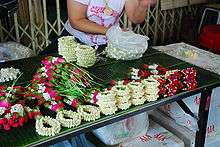Phuang malai
Phuang malai (Thai: พวงมาลัย, pronounced [pʰūa̯ŋ māːlāj]) or malai (มาลัย, [māːlāj]) are a Thai form of floral garland. They are often given as offerings or kept for good luck.


Origins
There is no written evidence on who first created phuang malai. The first record of phuang malai was found during the reign of King Chulalongkorn.[1] There was a literary work written by the king called Phra Ratchaphithi Sip Song Duean ('Twelve-Months Royal Ceremonies') which contained information about events and ceremonies in the Sukhothai Kingdom. In the 4th month ceremony, it was mentioned that fresh flower garlands were made by the king's chief concubine Thao Sichulalak (ท้าวศรีจุฬาลักษณ์).[2] Then, in the Rattanakosin Kingdom the phuang malai became an important ornamental object in every ceremony. Every girl in the palace was expected to acquire the skills of making phuang malai. Queen Saovabha Phongsri devised a wide variety of intricate phuang malai patterns.[1]
Patterns
Phuang malai patterns can be divided into six groups.
- Creature malai resembles animals. Flowers are arranged into animal shapes such as mouse, rabbit, squirrel, and gibbon.
- Chained malai is a series of rounded malai connected together which resemble a chain.
- Braided malai two rounded malai connected together, decorated with pine-shaped malai on each end.
- Vine malai is a series of semicircular malai arranged in a vine shape.
- Laced malai is a malai fully decorated by inserting golden and silver laces all over the malai both inside and out.
- Orchid malai is made only from orchids.[3]
Uses
Phuang malai can be classified into three categories by use.
- Malai chai diao (มาลัยชายเดียว, [māːlāj t͡ɕʰāːj dīa̯w]) is usually used as an offering to show respect. In temples and cemeteries, these malai can be seen hanging from the hands of Buddhist monk statues along with votive candles. Chained malai and braided malai are examples of malai chai diao.
- Malai song chai (มาลัยสองชาย, [māːlāj sɔ̌ːŋ t͡ɕʰāːj]) is usually draped around a person's neck to show importance. In the Thai wedding ceremony, both bride and groom often wear malai song chai.
- Malai chamruai or souvenir malai (มาลัยชำร่วย, [māːlāj t͡ɕʰām.rûa̯j]), the smallest form of malai, is usually given as a souvenir to a large group of people.[4] These malai are customarily given by a host, for instance, in wedding ceremonies, housewarming ceremonies, birthday parties, and baby showers. Creature malai is one form of malai chamruai.[2] The purpose of malai chamruai is similar to that of lei (garland) in Hawaiian culture.
In addition to the use of the malai as offerings, gifts, and souvenirs, malai have many more functions. They can be used to decorate throne halls and houses. Malai can also be hung on Thai musical instruments to pay respect to the masters of those instruments and for good luck and success in a performance.[1]
Bamboo garlands
Thai bamboo garlands are decorative woven offerings sometimes used as a substitute for floral garlands and as a way to hang other offerings. Bamboo garlands are part of the tradition of Phu Thai people in the village of Kut Wa in Kuchinarai District, Kalasin Province, in the northeast of Thailand. Bamboo garlands are also used in the festival of Buddhist Lent during the Thai rainy season, called "Bun Khao Pradap Din" or "Bun Phuang Malai Ban Kut Wa".
Bamboo garland ceremony, Kut Wa, Thailand
To celebrate Phu Thai, the villagers of Kut Wa create ornate garlands and form a procession around Wat Kok to display their handiwork, with dancing, singing, and rhythmic drumming.[5]
See also
- Buddhist prayer beads
- Hindu prayer beads
- Mala, used in India
- Lei (garland)
- Namaste
- Pranāma
References
- กระทรวงศึกษาธิการ. กรมการศึกษานอกโรงเรียน.หนังสือเรียนวิชาช่างดอกไม้สด.การจัดดอกไม้มาลัย(2535)
- "Archived copy". Archived from the original on 2012-09-07. Retrieved 2013-11-13.CS1 maint: archived copy as title (link)
- จันทนา สุวรรณมาลี. มาลัย.ประเภทของมาลัย(2533)
- มหาวิทยาลัยราชภัฎสวนดุสิต. สถาบันภาษา.ดอกไม้กับวิถีชีวิตของคนไทย.มาลัย(2552)
- "Thailand's Festivities". Thailand's Festivities. Events Division Tourism Authority of Thailand. Archived from the original on 3 June 2016. Retrieved 23 May 2016.